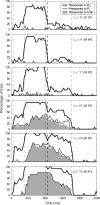Simultaneous measurement of noise-activated middle-ear muscle reflex and stimulus frequency otoacoustic emissions
- PMID: 16568366
- PMCID: PMC2504580
- DOI: 10.1007/s10162-006-0028-9
Simultaneous measurement of noise-activated middle-ear muscle reflex and stimulus frequency otoacoustic emissions
Abstract
Otoacoustic emissions serve as a noninvasive probe of the medial olivocochlear (MOC) reflex. Stimulus frequency otoacoustic emissions (SFOAEs) elicited by a low-level probe tone may be the optimal type of emission for studying MOC effects because at low levels, the probe itself does not elicit the MOC reflex [Guinan et al. (2003) J. Assoc. Res. Otolaryngol. 4:521]. Based on anatomical considerations, the MOC reflex activated by ipsilateral acoustic stimulation (mediated by the crossed olivocochlear bundle) is predicted to be stronger than the reflex to contralateral stimulation. Broadband noise is an effective activator of the MOC reflex; however, it is also an effective activator of the middle-ear muscle (MEM) reflex, which can make results difficult to interpret. The MEM reflex may be activated at lower levels than measured clinically, and most previous human studies have not explicitly included measurements to rule out MEM reflex contamination. The current study addressed these issues using a higher-frequency SFOAE probe tone to test for cochlear changes mediated by the MOC reflex, while simultaneously monitoring the MEM reflex using a low-frequency probe tone. Broadband notched noise was presented ipsilaterally at various levels to elicit probe-tone shifts. Measurements are reported for 15 normal-hearing subjects. With the higher-frequency probe near 1.5 kHz, only 20% of subjects showed shifts consistent with an MOC reflex in the absence of an MEM-induced shift. With the higher-frequency probe near 3.5 kHz, up to 40% of subjects showed shifts in the absence of an MEM-induced shift. However, these responses had longer time courses than expected for MOC-induced shifts, and may have been dominated by other cochlear processes, rather than MOC reflex. These results suggest caution in the interpretation of effects observed using ipsilaterally presented acoustic activators intended to excite the MOC reflex.
Figures










Similar articles
-
Contralateral suppression of distortion product otoacoustic emissions and the middle-ear muscle reflex in human ears.Hear Res. 2008 Mar;237(1-2):66-75. doi: 10.1016/j.heares.2007.12.004. Epub 2007 Dec 28. Hear Res. 2008. PMID: 18258398
-
Frequency tuning of medial-olivocochlear-efferent acoustic reflexes in humans as functions of probe frequency.J Neurophysiol. 2012 Mar;107(6):1598-611. doi: 10.1152/jn.00549.2011. Epub 2011 Dec 21. J Neurophysiol. 2012. PMID: 22190630 Free PMC article.
-
Human medial olivocochlear reflex: effects as functions of contralateral, ipsilateral, and bilateral elicitor bandwidths.J Assoc Res Otolaryngol. 2009 Sep;10(3):459-70. doi: 10.1007/s10162-009-0163-1. Epub 2009 Mar 5. J Assoc Res Otolaryngol. 2009. PMID: 19263165 Free PMC article.
-
Olivocochlear efferents: anatomy, physiology, function, and the measurement of efferent effects in humans.Ear Hear. 2006 Dec;27(6):589-607. doi: 10.1097/01.aud.0000240507.83072.e7. Ear Hear. 2006. PMID: 17086072 Review.
-
Olivocochlear efferents: Their action, effects, measurement and uses, and the impact of the new conception of cochlear mechanical responses.Hear Res. 2018 May;362:38-47. doi: 10.1016/j.heares.2017.12.012. Epub 2017 Dec 21. Hear Res. 2018. PMID: 29291948 Free PMC article. Review.
Cited by
-
Changes in otoacoustic emissions during selective auditory and visual attention.J Acoust Soc Am. 2015 May;137(5):2737-57. doi: 10.1121/1.4919350. J Acoust Soc Am. 2015. PMID: 25994703 Free PMC article.
-
Effects of cochlear synaptopathy on middle-ear muscle reflexes in unanesthetized mice.Hear Res. 2018 Jun;363:109-118. doi: 10.1016/j.heares.2018.03.012. Epub 2018 Mar 13. Hear Res. 2018. PMID: 29598837 Free PMC article.
-
Medial olivocochlear efferent reflex inhibition of human cochlear nerve responses.Hear Res. 2016 Mar;333:216-224. doi: 10.1016/j.heares.2015.09.001. Epub 2015 Sep 11. Hear Res. 2016. PMID: 26364824 Free PMC article.
-
Medial olivocochlear-induced transient-evoked otoacoustic emission amplitude shifts in individual subjects.J Assoc Res Otolaryngol. 2013 Dec;14(6):829-42. doi: 10.1007/s10162-013-0409-9. Epub 2013 Aug 28. J Assoc Res Otolaryngol. 2013. PMID: 23982894 Free PMC article.
-
Overshoot measured physiologically and psychophysically in the same human ears.Hear Res. 2010 Sep 1;268(1-2):22-37. doi: 10.1016/j.heares.2010.04.007. Epub 2010 Apr 27. Hear Res. 2010. PMID: 20430072 Free PMC article.
References
-
- {'text': '', 'ref_index': 1, 'ids': [{'type': 'DOI', 'value': '10.1016/0378-5955(93)90015-S', 'is_inner': False, 'url': 'https://doi.org/10.1016/0378-5955(93)90015-s'}, {'type': 'PubMed', 'value': '8113128', 'is_inner': True, 'url': 'https://pubmed.ncbi.nlm.nih.gov/8113128/'}]}
- Berlin CI, Hood LJ, Wen H, Szabo P, Cecola RP, Rigby P, Jackson DF. Contralateral suppression of non-linear click-evoked otoacoustic emissions. Hear. Res. 71:1–11, 1993. - PubMed
-
- {'text': '', 'ref_index': 1, 'ids': [{'type': 'DOI', 'value': '10.3109/00206098109072698', 'is_inner': False, 'url': 'https://doi.org/10.3109/00206098109072698'}, {'type': 'PubMed', 'value': '7213209', 'is_inner': True, 'url': 'https://pubmed.ncbi.nlm.nih.gov/7213209/'}]}
- Blood IM, Greenberg HJ. Low-level acoustic reflex thresholds. Audiology 20:244–250, 1981. - PubMed
-
- {'text': '', 'ref_index': 1, 'ids': [{'type': 'DOI', 'value': '10.1016/S0006-8993(99)02227-1', 'is_inner': False, 'url': 'https://doi.org/10.1016/s0006-8993(99)02227-1'}, {'type': 'PubMed', 'value': '10661505', 'is_inner': True, 'url': 'https://pubmed.ncbi.nlm.nih.gov/10661505/'}]}
- Buki B, Wit HP, Avan P. Olivocochlear efferent vs. middle-ear contributions to the alteration of otoacoustic emissions by contralateral noise. Brain Res. 852:140–150, 2000. - PubMed
-
- {'text': '', 'ref_index': 1, 'ids': [{'type': 'DOI', 'value': '10.1016/0378-5955(93)90239-W', 'is_inner': False, 'url': 'https://doi.org/10.1016/0378-5955(93)90239-w'}, {'type': 'PubMed', 'value': '8340262', 'is_inner': True, 'url': 'https://pubmed.ncbi.nlm.nih.gov/8340262/'}]}
- Burns EM, Harrison W, Bulen JC, Keefe DH. Voluntary contraction of middle ear muscles: effects on input impedance, energy reflectance, and spontaneous otoacoustic emissions. Hear. Res. 67:117–127, 1993. - PubMed
-
- {'text': '', 'ref_index': 1, 'ids': [{'type': 'DOI', 'value': '10.1016/0378-5955(90)90232-E', 'is_inner': False, 'url': 'https://doi.org/10.1016/0378-5955(90)90232-e'}, {'type': 'PubMed', 'value': '2312416', 'is_inner': True, 'url': 'https://pubmed.ncbi.nlm.nih.gov/2312416/'}]}
- Collet L, Kemp DT, Veuillet E, Duclaux R, Moulin A, Morgon A. Effect of contralateral auditory stimuli on active cochlear micro-mechanical properties in human subjects. Hear. Res. 43:251–262, 1990. - PubMed
Publication types
MeSH terms
Grants and funding
LinkOut - more resources
Full Text Sources

